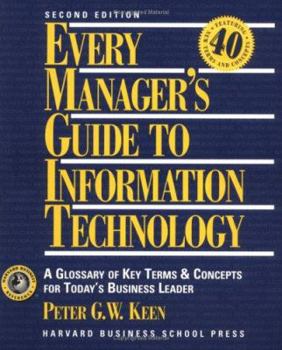Every Manager's Guide to Information Technology
Select Format
Select Condition 
Book Overview
Business processes comprise how work is coordinated, streamlined, & targeted to meet fundamental goals (e.g., customer service, time to market, & effective decision making). This book identifies &... This description may be from another edition of this product.
Format:Paperback
Language:English
ISBN:0875845711
ISBN13:9780875845715
Release Date:December 1994
Publisher:Harvard Business Review Press
Length:290 Pages
Weight:1.25 lbs.
Dimensions:0.8" x 7.5" x 9.2"
Customer Reviews
1 rating
Outstanding executive summary, readable, insightful
Published by Thriftbooks.com User , 25 years ago
The fundamental role of information technology (IT) in the identification and transformation of business processes is clear in this outstanding contribution from Peter Keen and Ellen Knapp. This concise work serves to promote the dialogue between the IT staff and the business experts. It communicates powerfully like a well-written executive summary. Although it reviews in a critical way and consolidates gains in the task of coordinating business processes undertaken by total quality management (TQM), business process reengineering (BPR), the learning organization, time-based competition (and a host of related -isms), at another level it provides a breakthrough way of looking at old things in new ways. "It is because there are so many approaches to coordinating business processes, with information technology a major enabler of dramatic change, that so much of the process movements' ideas seem at once old and new" (p. 23). That breakthrough is entitled the "business process investment" framework (p. 30ff.). It is a framework for a conversation between the IT and the business roles and functions in the modern firm. If any doubt existed as to the fundamental significance of the business - IT conversation, then the references in this work on client-server, groupware, electronic data interchange (EDI), image processing, (computer system) integration, and UNIX, will put to rest any question as to the salience of the task. As usual, IT is the "enabler," the catalyst, the provider of infra-structure. For example: "Image processing joins client/server computing and groupware as a core technology for process innovation. It does not create but rather enables many forms and degrees of innovation that are simply not possible when physical documents drive the process" (p. 125). The inquiry undertaken by Keen and Knapp aims at solving what they call the "process paradox" (p. 165). Major business process reengineering efforts fail to furnish value-added, bottom line profits, in spite of being successful technically and even organizationally. That is the paradox: great benefits, no value-added. The resolution: the wrong processes were reengineered. A fundamental distinction exists between "...getting a process right and getting the right process right" (p. 165). But how do we tell what are the right processes to get right? The short answer is to distinguish "identity processes," which are a lot like "core competencies" (what a company does best), from "liability and background processes". An identity process is what makes a company what it is. For example, the guaranteed on-time delivery for Fed Ex; product innovation for 3M; Nordstrom's customer service; Managed Care in health insurance. In each case, the process stands for the company. That is the process into which development effort should be committed. What should be done with the other processes? If they can't be stopped, e.g., because the




